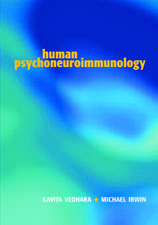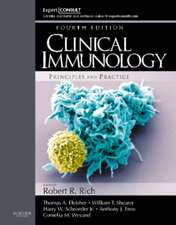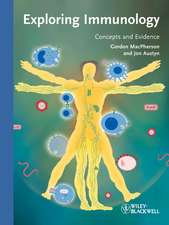The Antibody Enigma
Autor Thomas Kindten Limba Engleză Paperback – 8 mar 2012
Preț: 367.84 lei
Preț vechi: 387.20 lei
-5% Nou
Puncte Express: 552
Preț estimativ în valută:
70.39€ • 73.08$ • 58.70£
70.39€ • 73.08$ • 58.70£
Carte tipărită la comandă
Livrare economică 22 martie-05 aprilie
Preluare comenzi: 021 569.72.76
Specificații
ISBN-13: 9781468446784
ISBN-10: 1468446789
Pagini: 292
Ilustrații: XVIII, 270 p.
Dimensiuni: 152 x 229 x 15 mm
Greutate: 0.4 kg
Ediția:Softcover reprint of the original 1st ed. 1984
Editura: Springer Us
Colecția Springer
Locul publicării:New York, NY, United States
ISBN-10: 1468446789
Pagini: 292
Ilustrații: XVIII, 270 p.
Dimensiuni: 152 x 229 x 15 mm
Greutate: 0.4 kg
Ediția:Softcover reprint of the original 1st ed. 1984
Editura: Springer Us
Colecția Springer
Locul publicării:New York, NY, United States
Public țintă
ResearchCuprins
1. The Nature of the Problem.- 1.1. Introduction.- 1.2. Antibody Synthesis.- 1.3. Historical Roots.- 1.4. Clonal Selection.- 1.5. Effector Functions.- >1.6. The Extent of Diversity—The Problem in a Nutshell.- 1.7. Scope of the Book.- 1.8. Precis.- References and Bibliography.- 2. The Serologist’s Approach to the Problem.- 2.1. Introduction.- 2.2. Rabbit Allotypes.- 2.3. Human Allotypes.- 2.4. Allotypes of the Mouse and the Rat.- 2.5. Individual Antigenic Specificity and Idiotypy.- 2.6. Idiotypes as Markers for Antibody-Binding Regions.- 2.7. The Inheritance of Idiotypes.- 2.8. Conclusion.- References and Bibliography.- 3. The Biochemist’s Approach to the Problem.- 3.1. Biochemical Studies on Heterogeneous Antibodies.- 3.2. Biochemical Studies on Homogeneous Antibodies.- 3.3. Structural Features of Immunoglobulin Isotypes and Allotypes.- 3.4. Structural Features of V Regions.- 3.5. Are the C Regions Really Constant?.- 3.6. Structural Analysis of Selected V Regions.- 3.7. Precis.- References and Bibliography.- 4. Unique Features of the Antibody Problem.- 4.1. Introduction.- 4.2. Structural Variability of Antibodies.- 4.3. Two Genes-One Polypeptide Chain.- 4.4. Allelic Exclusion.- 4.5. The Three Loci for Immunoglobulins.- 4.6. Conclusion.- References and Bibliography.- 5. The Polar Solutions.- 5.1. Introduction.- 5.2. The Germline Theory.- 5.3. The Somatic Mutation Theory.- 5.4. Data Favoring Germline Theories.- 5.5. Data Favoring Somatic Mutation Models.- 5.6. Waiting for the Answer.- References and Bibliography.- 6. The Maverick Solutions.- 6.1. Introduction.- 6.2. Data Difficult to Rationalize with Either Germline or Somatic Theories.- 6.3. The Maverick Solutions.- 6.4. Precis.- References and Bibliography.- 7. The Molecular Biologists Attack the Problem.- 7.1.Introduction.- 7.2. Gene Counting by Liquid Hybridization.- 7.3. Recombinant DNA Methods.- 7.4. The Two-Gene Hypothesis Reinvestigated.- 7.5. Heavy Chain Genes.- 7.6. The V Gene Segment.- 7.7. Heavy Chain C-Region Genes.- 7.8. Allelic Exclusion.- 7.9. Mapping the Immunoglobulin Genes.- 7.10. Conclusions.- References and Bibliography.- 8. Antibody Diversity: A Contemporary Solution.- 8.1. Introduction.- 8.2. There Are a Modest Number of Germline Genes.- 8.3. Combinatorial Joining of V/J and V, D, and J Gene Segments.- 8.4. Junctional Diversity Is Created by Alternate Frames of Recombination between Germline V, D, and J Gene Segments.- 8.5. Somatic Mutation in All Gene Segments Leads to Further Diversity.- 8.6. The Number of C-Region Genes Is Limited and Varies Considerably among the Species.- 8.7. Further Considerations for Antibody Diversity.- 8.8. Gene Families and Specificity.- 8.9. V-Region Polymorphism.- 8.10. Evolution of V and J Gene Segments.- 8.11. Somatic Mutation Revisited.- 8.12. Why Do We Have Certain Germline Genes?.- 8.13. Horizons.- 8.14. Precis.- References and Bibliography.









